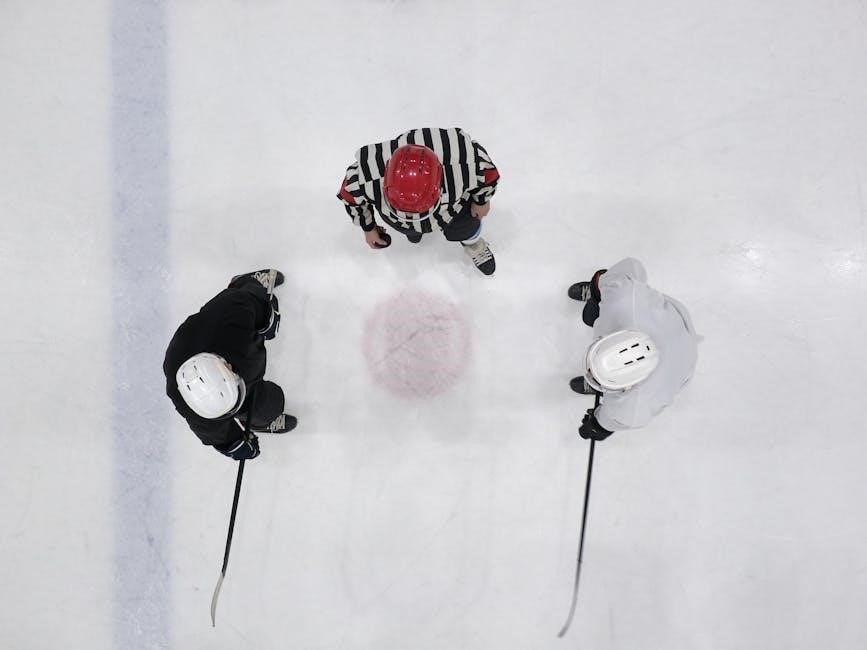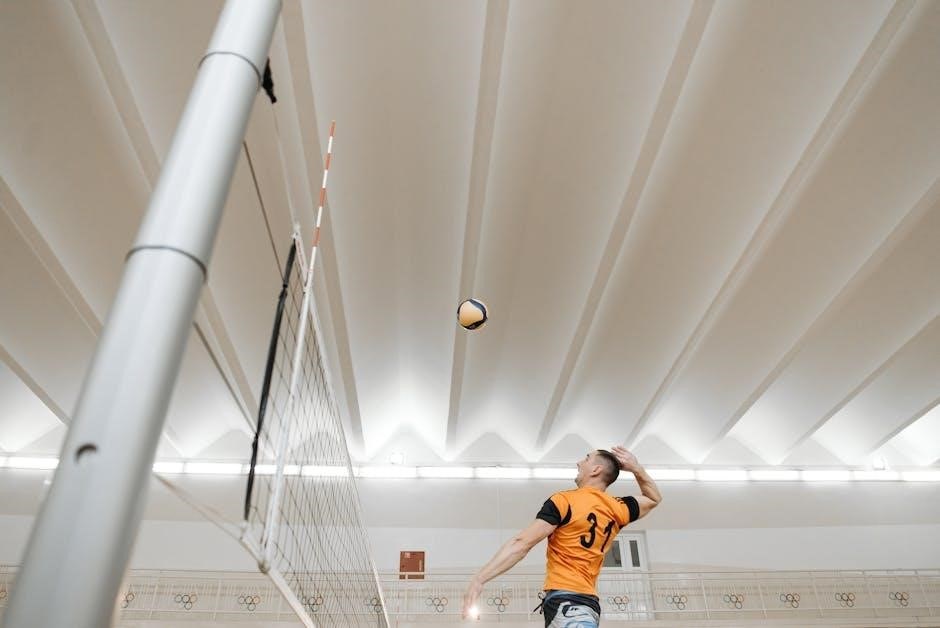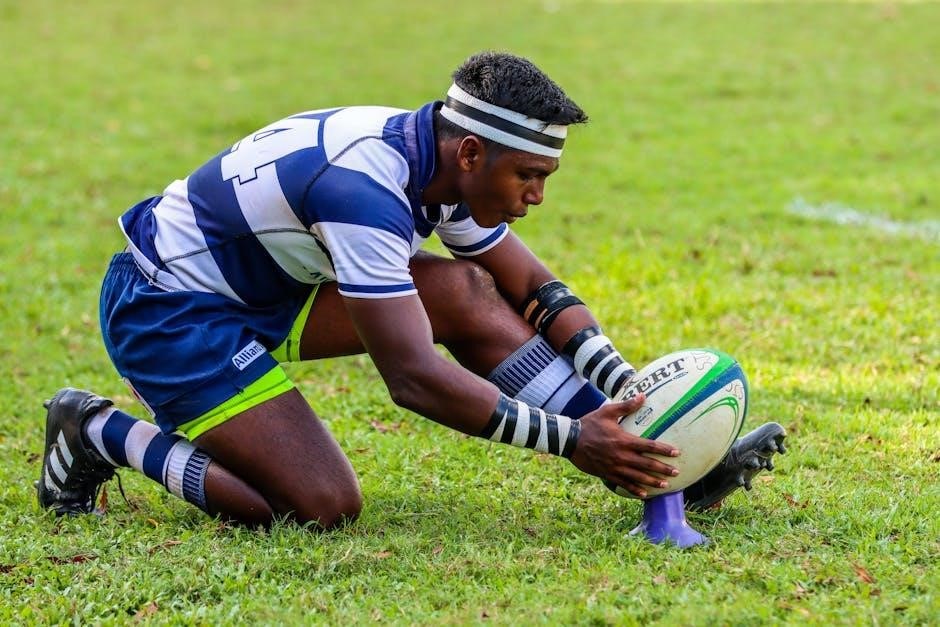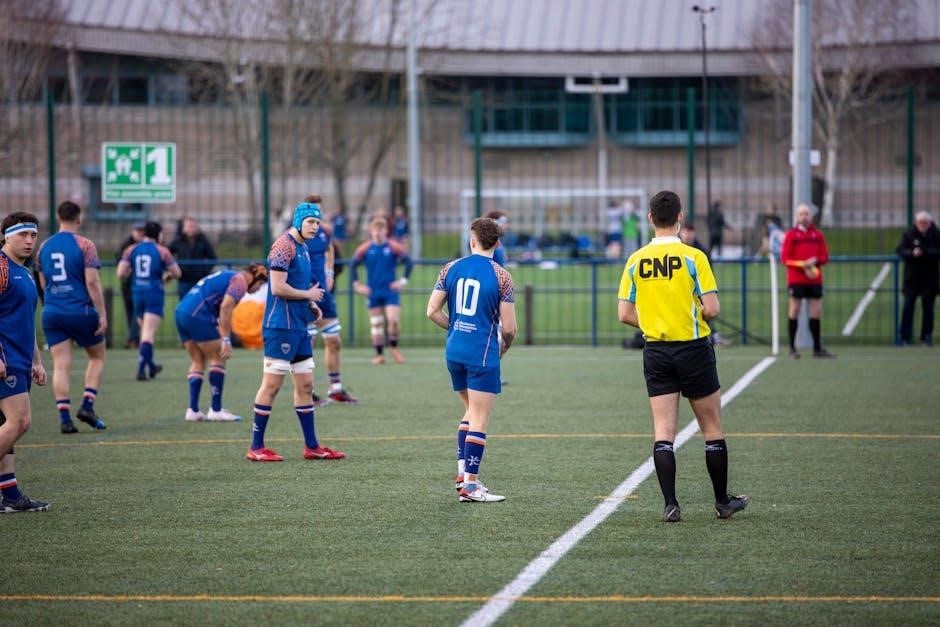Rugby League training drills are essential for skill development, focusing on passing, tackling, and agility. Resources like Rugby League Coaching Manuals and the NRL Drill Library offer structured sessions to enhance player performance and team strategy effectively.
Overview of Rugby League and Its Training Requirements
Rugby League is a dynamic, contact team sport requiring precision, strength, and endurance. Training drills are tailored to enhance basic skills like grip, catch, pass, and tackle, while fostering teamwork. Resources such as Rugby League Coaching Manuals and the NRL Drill Library provide structured sessions. For players aged 5-14, drills focus on skill acquisition, ensuring a strong foundation. Training sessions blend attack and defense principles, keeping activities engaging. The goal is to improve technical proficiency and physical fitness through drills, games, and conditioned exercises. Coaches are encouraged to adapt sessions to suit player needs, ensuring fun and inclusivity while developing core competencies. These structured approaches help players progress effectively, preparing them for competitive play and lifelong participation in the sport.

Importance of Structured Training Drills in Rugby League
Structured training drills are vital for Rugby League success, ensuring players master essential skills efficiently. These drills enhance technical abilities like passing, tackling, and ball control, while improving agility and speed. By focusing on specific exercises, players build a strong foundation, reducing injury risks and boosting performance. Coaches can tailor drills to address individual needs, fostering consistent progress. Additionally, structured sessions promote teamwork and strategic play, essential for competitive matches. Resources such as the Rugby League Coaching Manuals and the NRL Drill Library offer proven methods to guide effective training. These tools help create engaging, goal-oriented practices that prepare players for game scenarios, ensuring they are well-equipped to excel on the field.

Key Components of Rugby League Training
Rugby League training focuses on skill acquisition, strength, and conditioning. Drills improve passing, tackling, and agility, while structured sessions enhance endurance and teamwork, preparing players for match demands effectively.
Skill Acquisition Drills for Players Aged 5-14
Drills for young players focus on developing fundamental skills like catching, passing, and ball control. Activities such as static passing drills and two-handed carry exercises are central. These drills are designed to be engaging and age-appropriate, ensuring players build confidence and technique. Coaches emphasize fun and participation, allowing kids to learn through play. Progression involves increasing difficulty, like moving from shorter to longer passes. The goal is to create a solid foundation for more complex skills as players grow. Structured sessions with clear coaching points help young athletes master the basics, preparing them for advanced training in the future. Safety and enjoyment remain top priorities at this developmental stage.
Defensive Drills: Tackling and Line Defense
Defensive drills in rugby league focus on building strength, technique, and coordination in tackling and line defense. Coaches use exercises like one-on-one tackling drills to improve players’ ability to bring opponents to the ground safely and effectively. Line defense drills emphasize staying compact, communicating, and reacting quickly to opposition movements; Players practice shifting as a unit and filling defensive gaps. Intercept passes and defensive positioning are also key areas of focus. Coaching points include proper body alignment, head placement, and leg drive during tackles. These drills help players develop the physical and mental skills needed to dominate defensively. Regular practice ensures a strong, cohesive defensive unit capable of withstanding opposition attacks; Safety and technique are prioritized to reduce injury risks while fostering resilience and teamwork.
Offensive Drills: Passing, Running, and Ball Handling
Offensive drills in rugby league are designed to enhance passing accuracy, running techniques, and ball control. Players practice static and moving passes, gradually increasing distance to improve precision. Running drills focus on agility and evasive maneuvers, such as side-steps and swerves, to outpace defenders. Ball handling exercises emphasize quick pick-ups and effective offloads. Coaches incorporate skill-biased games to simulate match scenarios, allowing players to apply these skills in real-time. These drills are tailored to improve coordination, speed, and teamwork, ensuring players can execute plays seamlessly during games. Regular practice builds confidence and fluidity in offensive strategies, enabling teams to maintain possession and create scoring opportunities effectively.
Agility and Speed Training in Rugby League
Agility and speed are crucial for rugby league success. Drills using cones and ladders improve footwork, while sprinting exercises enhance acceleration and reaction time, boosting overall performance.
Drills to Improve Speed and Agility
Speed and agility are fundamental for rugby league players to excel on the field. Effective drills include ladder footwork exercises and cone weaving challenges, which enhance quick directional changes. Shuttle runs and reaction sprints are excellent for improving acceleration and responsiveness. Players can also engage in drills that involve rapid lateral movements and zigzag runs to boost agility. Additionally, incorporating exercises that require quick bursts of speed and sharp turns can significantly enhance performance. These drills not only improve physical abilities but also contribute to better decision-making during matches. By regularly practicing these exercises, players can achieve superior speed and agility, giving them a competitive edge in the game.
Cones and Ladder Drills for Enhanced Footwork
Cones and ladder drills are highly effective for improving footwork in rugby league players. These exercises focus on agility, balance, and quick changes of direction. Players weave through cones or step through ladders using techniques like the “Ickey Shuffle” or “Carioca” drill to enhance lateral movement. Drills such as zigzag runs around cones or rapid footwork through ladders improve coordination and speed. Coaches often incorporate variations, such as adding ball handling or reaction elements, to simulate game scenarios. These drills are versatile and can be tailored to suit players of all skill levels, from juniors to professionals. Regular practice of cone and ladder exercises ensures players develop the footwork necessary to outmaneuver opponents on the field.

Strength and Conditioning for Rugby League Players
Rugby league players require robust strength and conditioning to enhance performance and prevent injuries. Weight training, plyometrics, and conditioning drills are essential for building power and endurance. Properly structured programs improve maximal aerobic power and overall athleticism, ensuring players can withstand the physical demands of the sport. Incorporating these elements into training ensures a strong foundation for both skill development and game readiness.
Weight Training Exercises for Rugby League

Weight training is a cornerstone of rugby league preparation, enhancing strength, power, and resilience. Key exercises include squats, deadlifts, and bench presses to build lower and upper body strength. Leg presses and lunges target leg muscles, essential for explosive acceleration and stability. Core exercises like planks and Russian twists improve stability and injury resistance. Conditioning drills, such as prowler pushes and weighted sprints, boost power and endurance. Players should focus on progressive overload, increasing weights or reps to continuously challenge muscles. Proper form and recovery are crucial to prevent injuries and optimize gains. Coaches often tailor programs to individual needs, ensuring a balance between strength, speed, and agility. A well-structured weight training regimen is vital for peak performance on the field.
Conditioning Drills for Endurance and Stamina
Conditioning drills are vital for building endurance and stamina in rugby league, enabling players to maintain high-intensity efforts throughout matches. Drills like interval sprints, shuttle runs, and prowler pushes are effective for improving cardiovascular fitness. Players can perform repeat efforts over varying distances (20-50 meters) with controlled rest periods to simulate game demands. Another popular drill involves a defender tackling as many attackers as possible in one minute, promoting both stamina and tackling technique. Coaches often incorporate game-based scenarios to enhance fitness while maintaining engagement. Proper warm-ups and cool-downs are essential to prevent injuries and aid recovery. These drills ensure players can sustain their performance over the full 80 minutes, making them indispensable for match readiness.
Coaching Tips and Session Planning
Coaches should ensure sessions are engaging, with drills tailored to skill levels. Keep activities fun and inclusive, allowing players to develop through structured, varied exercises.
How to Structure a Effective Training Session
A well-structured Rugby League training session enhances player development and engagement. Begin with a warm-up to prepare physically and mentally. Follow with skill-focused drills, such as passing and tackling, ensuring each activity builds on the previous one. Incorporate small-sided games to apply skills in match-like scenarios. Conclude with conditioning exercises to boost endurance and strength. Always include cool-down stretches to prevent injuries. Coaches should adapt drills based on player age and skill level, ensuring fun and inclusivity. Vary activities to maintain interest and optimize learning. Structured sessions not only improve performance but also foster teamwork and discipline among players.
Coaching Points for Skill Development
Effective coaching in Rugby League focuses on clear, concise instructions to enhance skill acquisition. Emphasize proper technique in passing, tackling, and ball handling to build a strong foundation. Use demonstrations and feedback to guide players, ensuring they understand key coaching points. For passing, highlight grip, body positioning, and accuracy. In tackling, stress safety, footwork, and effective contact. Encourage players to stay low, use both arms, and drive through the tackle. For ball handling, focus on grip, control, and vision. Positive reinforcement and gradual progression of drills help players improve confidently. Coaches should adapt drills to suit different age groups and skill levels, ensuring each player participates actively and learns effectively.
Effective Rugby League training drills enhance performance and safety. Visit Rugby League Coaching Manuals (RLCM) and the NRL Drill Library for comprehensive resources and skill development guides.
Final Thoughts on Effective Rugby League Training
Effective Rugby League training requires a balanced approach, combining skill acquisition, strength, agility, and conditioning. Coaches should ensure drills are age-appropriate, engaging, and safe, fostering both individual and team growth. Incorporating structured sessions from resources like Rugby League Coaching Manuals and the NRL Drill Library can enhance player development. Emphasizing proper technique, gradual progression, and positive feedback creates a conducive learning environment. By aligning training with specific objectives and adapting drills to meet player needs, coaches can maximize performance and reduce injury risks. Consistency and variety in training are key to building a well-rounded, competitive team.
Recommended Resources for Coaches and Players
Coaches and players can benefit from the Rugby League Coaching Manuals (RLCM), available at www.rlcm.com.au, which provide comprehensive guides for drills, skill development, and session planning; The NRL Drill Library is another valuable resource, offering a wide range of skill-biased games and exercises to enhance player performance. For junior coaches, the RLCM includes specific manuals tailored for younger players, focusing on fun and engaging activities. Additionally, resources like Touch/Tag Games for Rugby League Training and conditioning drills from RLCM can help improve fitness and reduce injury risks. These tools are essential for structuring effective training sessions and ensuring players develop the necessary skills to excel in the game.





